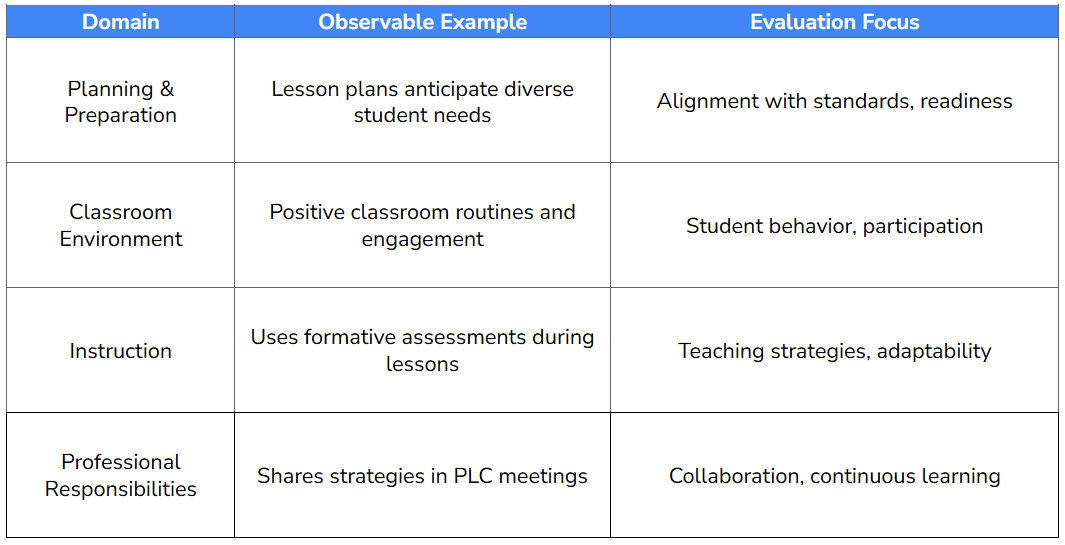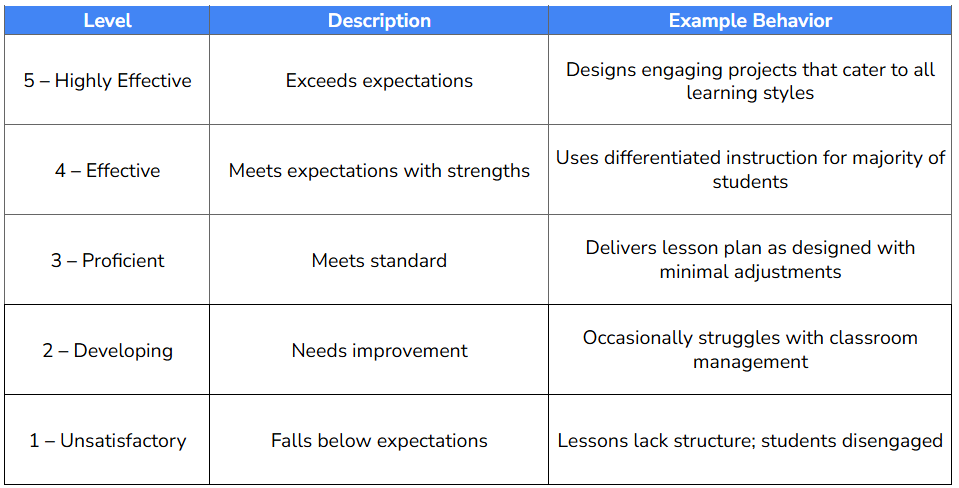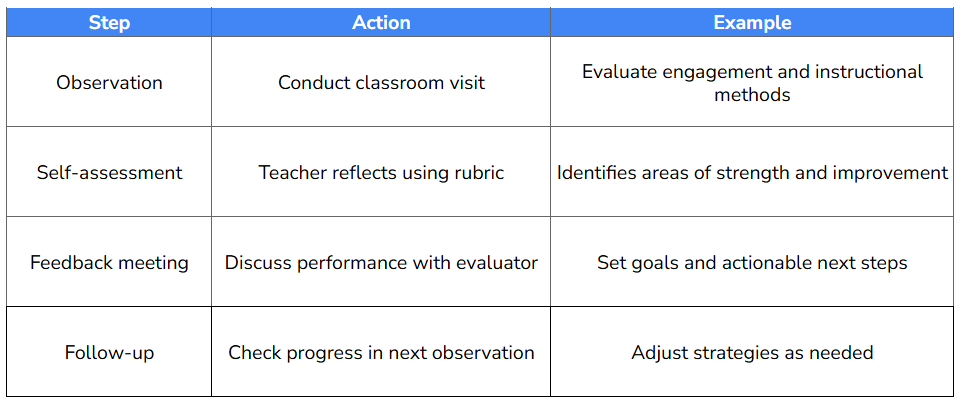Great teaching changes lives, but knowing how to measure and support it can be challenging. A teacher evaluation rubric offers clear, specific criteria to not only assess but also enhance teaching performance.
Grounded in education standards, these rubrics help identify strengths, highlight opportunities for growth, and guide professional development with fairness and clarity.
In this guide, we’ll explore how to design, implement, and fully leverage these tools to improve teaching quality and educational outcomes.
Key Takeaways
- Teacher evaluation rubrics offer a clear framework to assess performance and guide professional growth, aligning with frameworks like Danielson and Marzano.
- Effective rubrics combine teaching standards, performance indicators, and observable behaviors to ensure transparency and objectivity.
- Involving teachers in developing and implementing rubrics fosters collaboration and ensures tools are practical and relevant for ongoing professional development.
Overview of Teacher Evaluation Rubrics
Teacher evaluation rubrics are more than just assessment tools. They’re practical roadmaps for everyday improvement.
They show where educators are excelling, where adjustments are needed, and the next steps to reach their goals.
Rubrics that pair clear performance indicators with actionable feedback help teachers focus on meaningful improvements. For example, it can help refine lesson plans for smoother transitions between activities.
Key Components of a Teacher Evaluation Rubric
An effective teacher evaluation rubric should capture the full scope of excellent teaching practice. Three key components form the backbone of these tools:
- Professional Teaching Standards
- Performance Indicators
- Observable Elements
Each plays a distinct role in ensuring evaluations are comprehensive, actionable, and evidence-based.
Professional Teaching Standards
Professional teaching standards define the core skills, knowledge, and behaviors that characterize effective educators. Serving as the rubric’s foundation, these standards ensure that evaluations are built on a robust, research-backed understanding of good teaching.
For example, the Danielson Framework organizes evaluation into domains such as:
- Curriculum Planning
- Instructional Methods
- Classroom Management
- Professional Responsibilities
By addressing these areas, rubrics can assess the full breadth of a teacher’s role.
Performance Indicators
Performance indicators translate broad standards into specific, measurable competencies. They clarify what teachers are expected to know and do at different performance levels, making evaluations more transparent.
In the Stronge Evaluation System, for instance, indicators focus on measurable student outcomes, connecting teacher performance directly to learning results. This specificity not only aids evaluators but also gives teachers a clear roadmap for improvement.
Observable Elements
Observable elements describe the concrete behaviors and actions evaluators should look for. These include:
- Teaching Strategies
- Student Engagement Techniques
- Classroom Management Approaches.
Rather than relying on subjective impressions, evaluators can note tangible evidence. For example, it can reflect how a teacher structures group activities or redirects off-task behavior.
This approach strengthens objectivity and ensures evaluations are rooted in real classroom practice.
Structuring Your Evaluation Rubric

A well-structured teacher evaluation rubric organizes all aspects of teaching practice while encouraging collaboration. Involving teachers in the creation process fosters ownership and ensures the rubric accurately reflects their daily responsibilities.
In other words, teachers are more likely to embrace evaluation tools when they see themselves represented in the criteria.
Although the format may vary across states or districts, most rubrics share a consistent structure: domains, performance levels, and indicators. This consistency ensures fair and reliable evaluations, while still allowing schools to tailor rubrics to their unique priorities and goals,
Domain Organization
Domains categorize teaching practice into distinct areas. For example, the Danielson Framework uses four main domains:
- Planning and Preparation: Crafting lesson plans, aligning curriculum framework with standards, and anticipating student needs. A great example is designing a week-long science module with interactive experiments that accommodate different learning styles.
- Classroom Environment: Creating a supportive and well-managed learning space. For example, using flexible seating and clear routines to foster student engagement.
- Instruction: Delivering content effectively through varied teaching strategies.
This includes, incorporating small-group discussions, project-based learning, and timely feedback. - Professional Responsibilities: Engaging in professional growth and collaborating with colleagues. For instance, participating in peer observation cycles and professional learning communities.
Observable behaviors within these domains are key for fair assessment. Using standardized observation protocols ensures evaluators focus on consistent, evidence-based indicators.
Sample Domain Table:

Performance Levels
Performance levels provide a structured way to rate teaching quality, often ranging from Highly Effective to Unsatisfactory. Most rubrics feature 4–5 levels, with Level 3 representing expected proficiency.
- Descriptors matter: Each level should describe observable behaviors.
For example, a highly effective teacher might actively differentiate lessons to challenge advanced learners while supporting struggling students. - Dynamic assessment: Teacher performance can fluctuate annually due to factors like class composition or curriculum changes, emphasizing the need for ongoing support.
- Actionable outcomes: Evaluation results guide professional development, improvement plans, or, in some cases, administrative decisions.
Sample Performance Levels Table:

Aligning with State and District Standards
Ensuring your rubric aligns with state and district standards guarantees relevance and fairness.
- Reflect state-approved teaching standards for accurate assessment of educator performance.
- Foster a shared language for teaching quality. Stronge Evaluation System emphasizes consistent descriptors to reduce evaluator subjectivity.
- Support uniform learning standards, helping correlate teacher performance with student achievement outcomes.
Implementing Teacher Evaluation Rubrics

Using teacher evaluation rubrics effectively goes beyond checking boxes. They are tools for growth and professional development.
Likewise, implementation requires attention to design, scoring scales, data collection, and alignment with proven frameworks.
Below, we’ll outline key steps for putting rubrics into practice.
Training Evaluators
Well-trained evaluators are a must for accurate and meaningful assessments. Principals, assistant principals, and department heads must understand how to apply rubrics consistently.
- Workshops and collaborative sessions: Structured training ensures evaluators grasp the rubric’s domains, indicators, and performance levels.
- Expert guidance: Effective evaluator training reduces bias and increases teacher trust in the evaluation process.
- Long-term benefits: Skilled evaluators lead to more precise feedback, higher teacher morale, and improved student outcomes.
Conducting Observations
Classroom observations form the backbone of evaluation and should be both systematic and varied.
Here are a few key practices:
- Mini-observations: Quick 10–15 minute check-ins every few weeks provide ongoing insight.
- Regular, unannounced visits: Captures authentic classroom interactions.
- Combination of announced and unannounced walkthroughs and informal observations: Offers a comprehensive view of teaching practices.
Providing Feedback
Feedback is the most powerful tool for driving teacher growth. Constructive, timely, and actionable guidance helps teachers reflect on their practice and develop new strategies.
Utilize these best practices for feedback:
- Specific and actionable: Focus on concrete behaviors, not vague statements.
For instance, you can say “Consider using exit tickets to check student understanding at the end of each lesson.” - Recognize strengths: Highlight what teachers are doing well to encourage continued excellence. For example, “Your group discussion activity engaged students and encouraged peer learning.”
- Timely and focused: Offer feedback soon after observations to maximize impact.
- Promote self-reflection: Encourage teachers to assess their own practice using the rubric.
Table showing an example of a feedback cycle:

Best Practices for Using Teacher Evaluation Rubrics

Proper use of teacher evaluation rubrics depends on clear communication, consistent follow-up, and collaborative engagement. When teachers understand expectations and receive regular feedback, rubrics become powerful tools for improving teaching quality and professional growth.
Continuous Improvement
Continuous improvement is the foundation of effective teaching. Rubrics help both evaluators and teachers focus on growth rather than just compliance.
Key strategies for continuous improvement:
- Evaluator training: Structured workshops with practical scenarios help administrators apply rubrics consistently. You can observe recorded lessons and score them using the rubric to calibrate evaluator judgments.
- Constructive feedback: Feedback should be specific, actionable, and tied directly to rubric criteria. Here is an example: “During the math lesson, using visual aids for problem-solving enhanced student understanding. Consider adding peer explanation activities next time.”
- Self-reflection: Teachers can use rubrics to identify personal strengths and areas for development, creating targeted professional growth plans.
Engaging Teachers
Teacher engagement in the evaluation process fosters a collaborative culture and shared accountability. Involving educators in both the development and implementation of rubrics ensures the tools are realistic, fair, and useful.
A few engagement strategies include:
- Including teachers in rubric design to reflect daily teaching realities.
- Encouraging open dialogue about evaluation expectations.
- Promote peer collaboration for sharing best practices.
Examples of Popular Teacher Evaluation Frameworks
Several well-established frameworks provide standardized assessments of teaching practices and a common language for instructional excellence.
These frameworks serve as the foundation for developing rubrics aligned with best practices and education standards.
The Danielson Framework
The Danielson Framework for Teaching provides a comprehensive structure for evaluating teacher effectiveness. Key domains include:
- Planning and Preparation
- Classroom Environment
- Instruction
- Professional Responsibilities
By focusing on these domains, the framework provides a holistic approach to assessing teaching and supports professional growth. Expert Charlotte Danielson emphasizes that clear performance standards help teachers recognize strengths, identify areas for improvement, and develop professionally.
Marzano’s Focused Teacher Evaluation Model
Marzano’s model emphasizes research-based strategies that enhance teaching effectiveness and student achievement.
It uses performance levels such as Effective, Developing, and Ineffective to guide evaluations. Also detailed focus statements link teaching practices to outcomes for a more comprehensive approach. Lastly, ongoing feedback loops and self-assessment allow continuous refinement.
Stronge Effectiveness Performance Evaluation System
The Stronge Evaluation System aligns teacher performance with student outcomes, using detailed rubrics to assess:
- Teachers
- Educational specialists
- School leaders
The system focuses on measurable student outcomes and incorporates multiple data sources such as observations and artifacts. This ensures evaluations are comprehensive, consistent, and fair, emphasizing professional growth alongside accountability.
Comparison Table of Frameworks:

Summary
Teacher evaluation rubrics are powerful tools for assessing and improving teaching practices. They create a consistent understanding of what effective teaching looks like and guide professional growth.
Key elements, such as teaching standards, performance indicators, and observable behaviors, ensure evaluations are objective, transparent, and actionable. When paired with best practices and genuine teacher involvement, they foster a culture of continuous improvement and shared accountability.
Try our Classroom Walkthrough Software free and see how easy it is to share immediate feedback, track professional growth, and coach educators for success. Empower your district, school, or coaching team to deliver impactful instruction every day.
{Insert CTA Section}
Frequently Asked Questions
Have questions? We’re happy to answer!
What Are the Key Components of a Teacher Evaluation Rubric?
The main components are professional teaching standards, performance indicators, and observable behaviors. Together, they provide a structured way to assess teaching while supporting ongoing professional growth.
How Can Teacher Evaluation Rubrics Be Aligned With State and District Standards?
Integrate state-approved teaching standards directly into the rubric. This ensures assessments remain relevant, consistent, and aligned with learning expectations.
What Are Some Popular Teacher Evaluation Frameworks?
Three widely used frameworks are the Danielson Framework, Marzano’s Focused Teacher Evaluation Model, and the Stronge Effectiveness Performance Evaluation System. Each offers a standardized approach to evaluating teaching quality.
How Often Should Classroom Observations Be Conducted?
Every 2–3 weeks is ideal for gathering accurate insights into a teacher’s performance. A mix of announced and unannounced visits provides a well-rounded view.
Why Is Feedback Important in the Teacher Evaluation Process?
Feedback helps teachers pinpoint areas for improvement, recognize strengths, and develop strategies for growth. Specific, timely feedback directly enhances teaching effectiveness and student learning.

![Best Teacher Evaluation Rubric for 2025 [Ultimate Guide]](https://educationwalkthrough.com/wp-content/uploads/2025/08/Best-Teacher-Evaluation-Rubric-for-2025-Ultimate-Guide-300x200.jpg)

